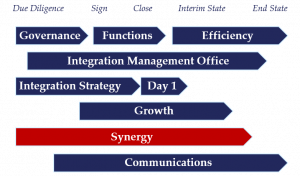M&A Integration Synergies
Along side work to understand current ways of working in both companies, cost of delivery, long-term strategy for the business post integration, the synergies can be identified.
Synergy projects identified by function, divisions, businesses and countries are reviewed by the IMO to ensure they are challenging and achievable, then consolidated into a high level plan. Individual business cases need to be prepared and approved via the IMO with delivery plans developed and approved.
Delivery of synergy projects can be complex and you must understand how early decisions affect them longer term. Therefore, a robust and accurate tracking and reporting process (including a reconciliation to business performance reporting) within the internal control framework must be implemented to ensure that delivery is kept on track (or additional support provided if slippage occurs). To support this a constant review of potential additional synergies should be part of this framework.


Synergy Estimation
There are usually a few high level synergy estimates, these need to be validated (Validate synergies – checking the synergies – i.e. check they are real, and do that again during their planning and delivery. Synergies are calculated, risks, implementation probability, and implementation steps are identified and documented) and then reviewed in detail. How will they be apportioned out across the different workstreams and business divisions, who will be responsible and accountable for each part.
They are split down into their component parts, and detailed plans set against each. Through tracking the actions which enable delivery we are more assured the synergies will be delivered.
The synergies are managed, like a business, each person is responsible for the resource and budgets that go into planning and delivering them.
We agreed how to check on the synergies – timing and scoping of meetings, responsibilities for facilitation, follow up.
Synergies should be tracked at steering group level to ensure top-level commitment and attention.
Finding more synergies
As we move though the deal process we gain more information about the company we are buying, whilst some synergies may become smaller or not actually be there, there may well be others. A chunk of work looking for and reviewing new synergies is useful, together with the forecast and manage expectation to enable gap resolution.
There will be new ideas for ways of working during the early stages of integration. Synergy workshops and meetings will help to check and track synergies, whilst enabling new ones.
Checking synergies
As we move through the deal from due diligence through to close, month 1, 3, 6 we need to re-evaluate the synergies. Time gives us more information and so we are more sure of the cost and benefit of each, the probability of achieving each.
This enables good decision making on where to invest time, money, management knowledge to plan and deliver the synergies. To understand risks for each part of the implementation and plan to mitigate team. Agree how to measure progress on synergy delivery and document them.
Ensuring good governance and approval of synergies, business cases and assigning responsibilities for budget & the actions that deliver the synergies. Checking for duplication of synergy counting, as we get into more detail.
Create Business Cases
Set up the business case template to ensure consistency of data.
Check all the synergies and make sure they all add up to what is needed in the overarching deal business case (or discounted cash flow – DCF)
Ensure the appropriate people see the business case and decisions are made rapidly, risks are identified and flagged and duplication in synergy counting reviewed and sorted out.
Check and count dis-synergies, sometimes they are not in the business cases. Loop back to the people who own the DCF and have the conversation that informs this deal and improves M&A in the future though informing future synergy and dis-synergy estimation.
Agree Plans
Agree all the integration plans that will deliver the synergies.
Understand risks and probability of delivery.
Check the planning progress as it goes along rather than waiting until the full plans are in, ensure all project fit together.
Ensure there is a clear and well understood approval criteria. What is the Return on Investment (ROI), hurdle rate, Internal Rate of Return (IRR), or payback that will get a project approved.
Tracking & Reporting
Check and track that synergies are fully executed and delivered. Understanding which are the key actions or milestones that will show synergies are being delivered. Tracking the actual synergies coming through and report on the progress of both. Ensure project governance and health checks are in place where needed. As well as good communications, a kick off strategy workshop and IMO (Integration Management Office)
Reporting Framework
Agree what will be reported, how and when. The structure of the monitoring and reporting for work streams and project. What is the correct frequency for each part of the business case and project.
Delivering Synergies
Synergies require change. It is essential to obtain a clear support, based on rational discussions, about the necessity to change existing practices. There should be a top down and a bottom up approach to understanding what they are and how to deliver them.
Mobilise and communicate. The communication effort is a significant part of the synergy work. Employees have to buy into the new working processes.
Mobilisation of the synergy projects and changes in the business and functions is often done by the business but need assistance in getting going to the right level, at the right speed with the right priority. Often done using a integration strategy workshop involving people from all parts of the business.
Finalise Documentation
For accounting purposes the synergies need to be correctly documented. So they can be audited.


